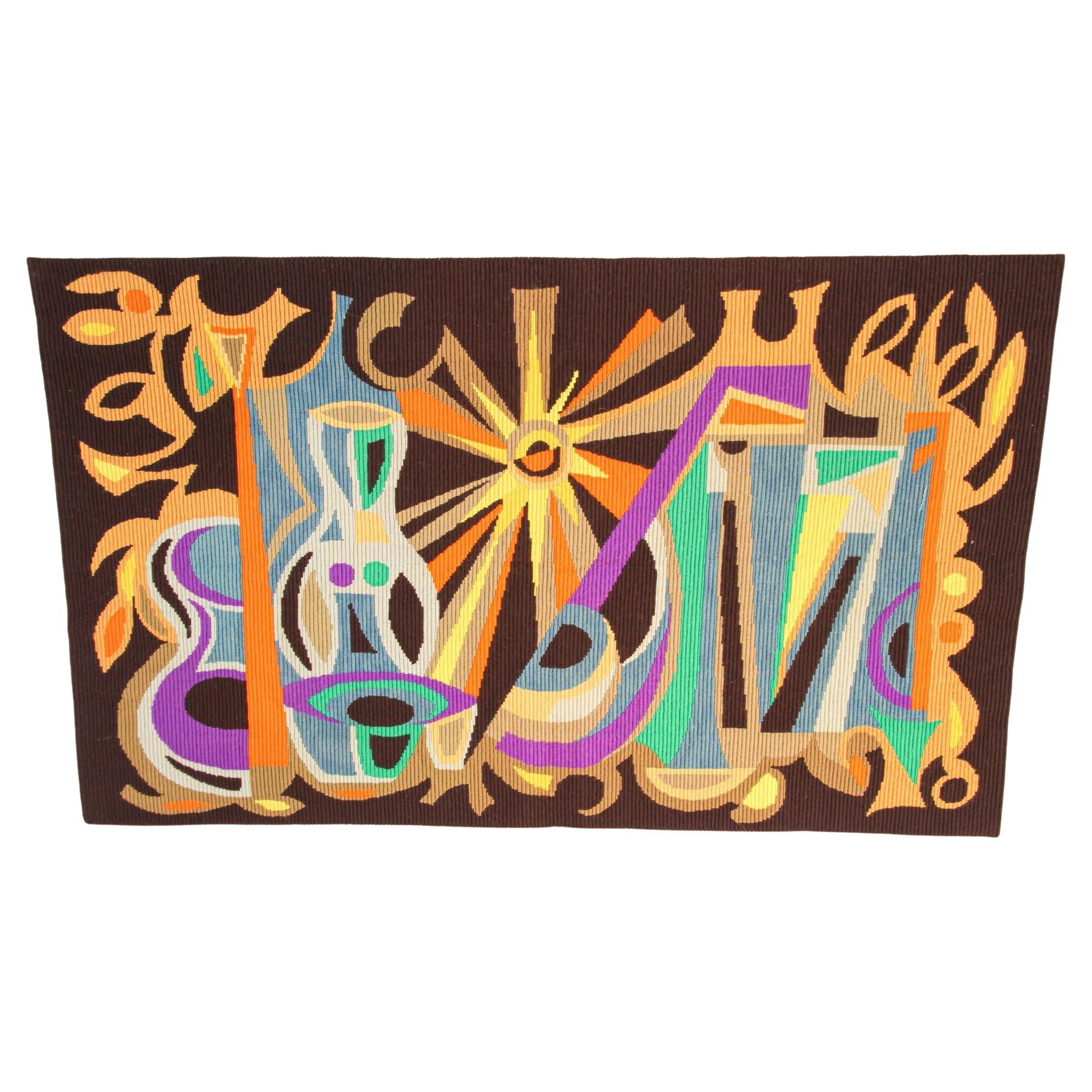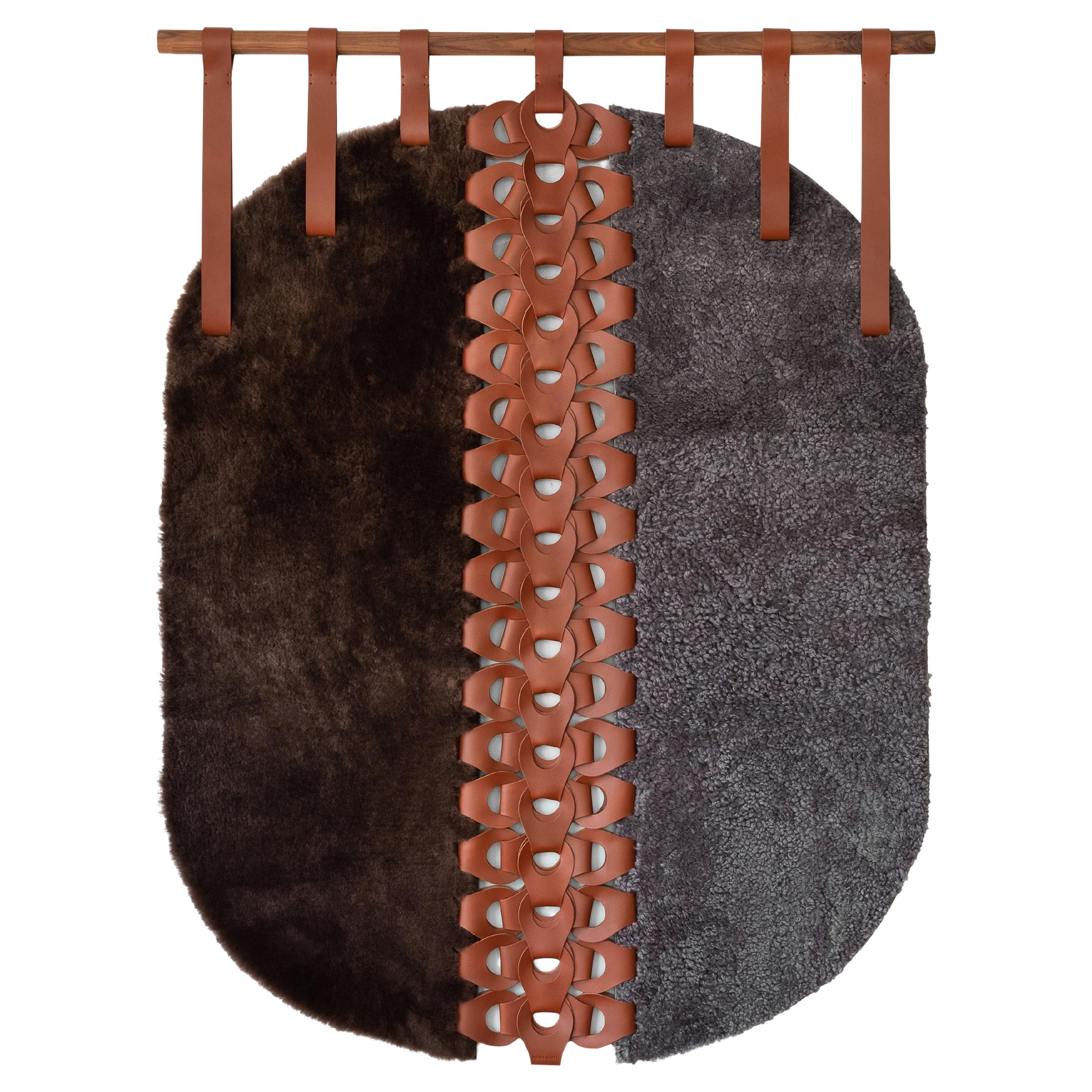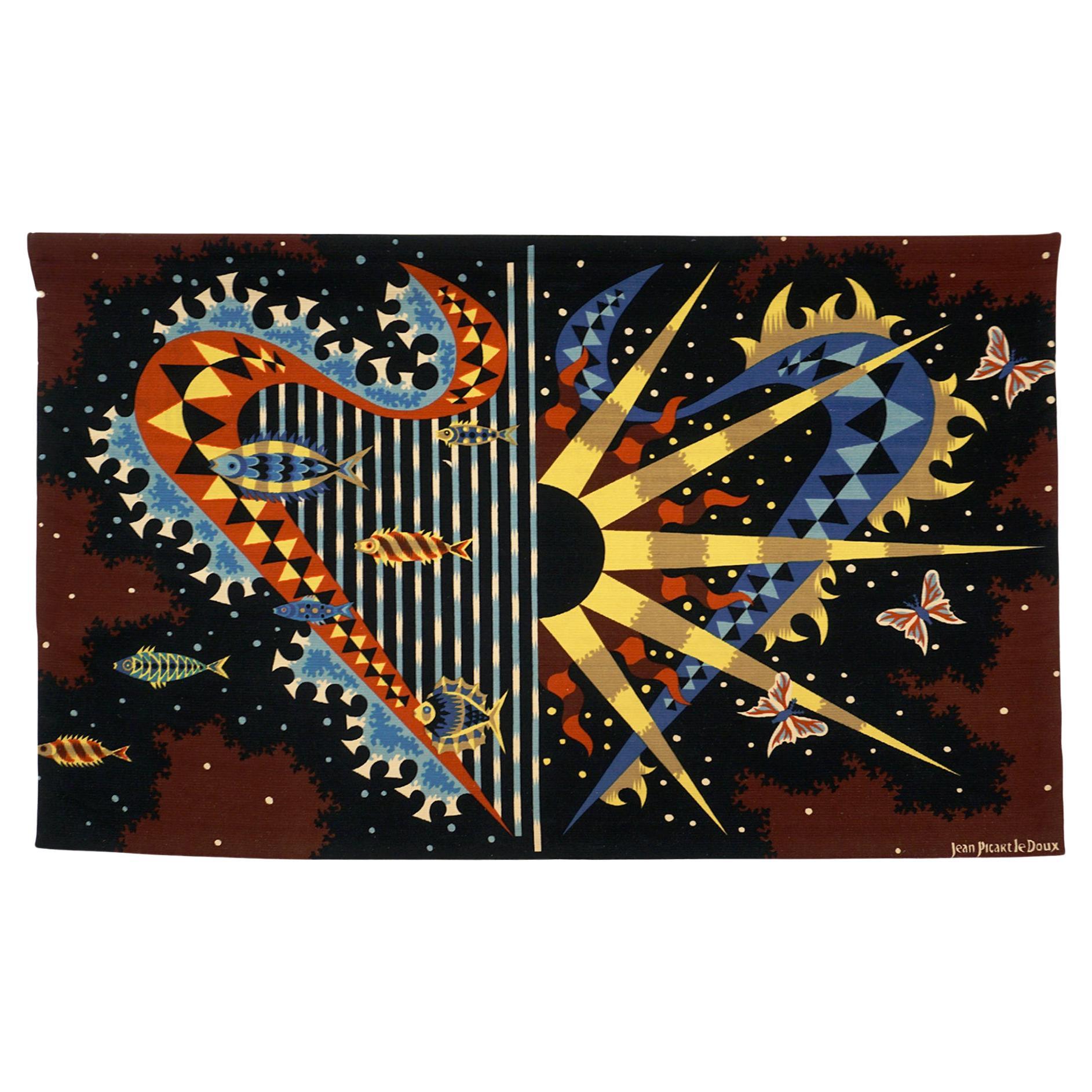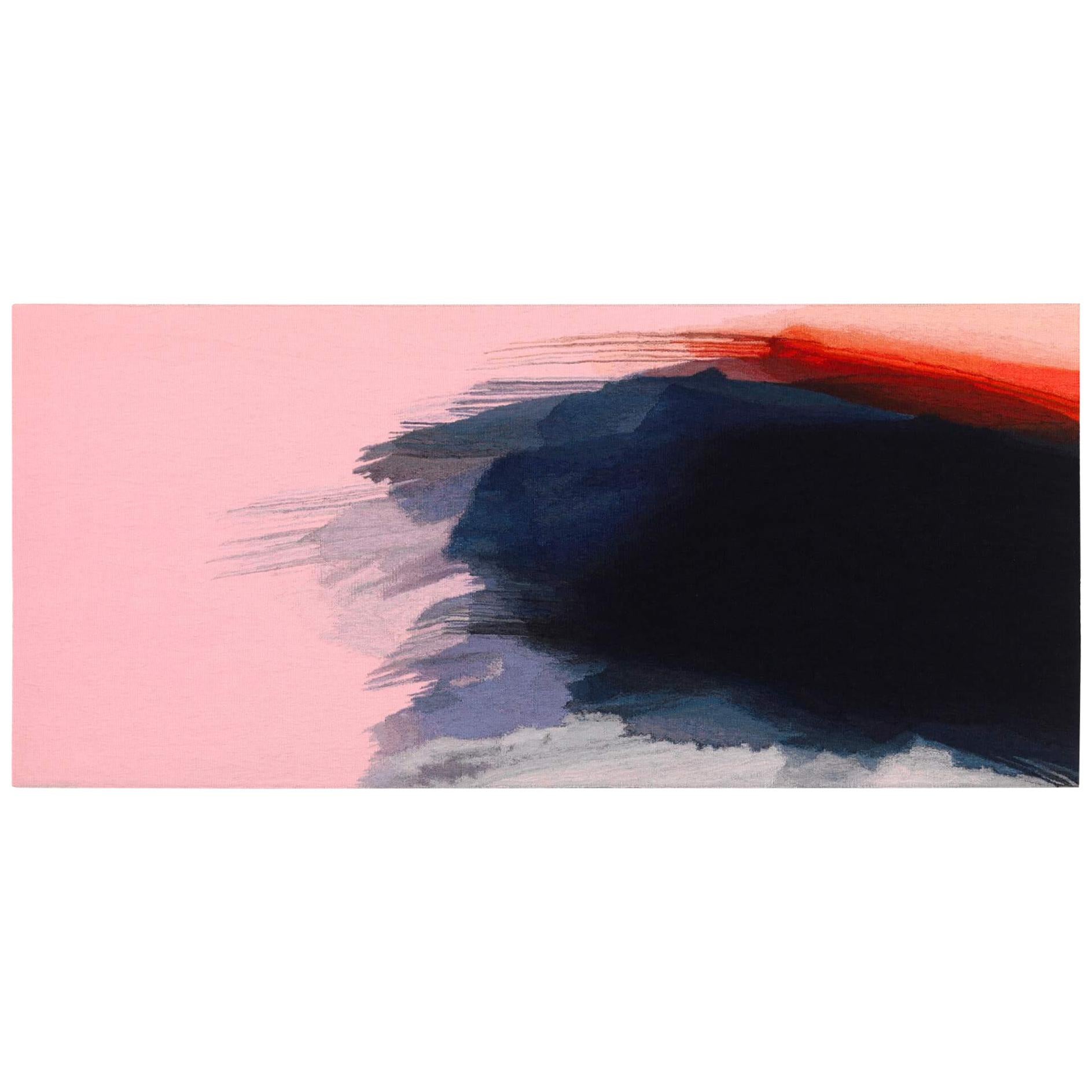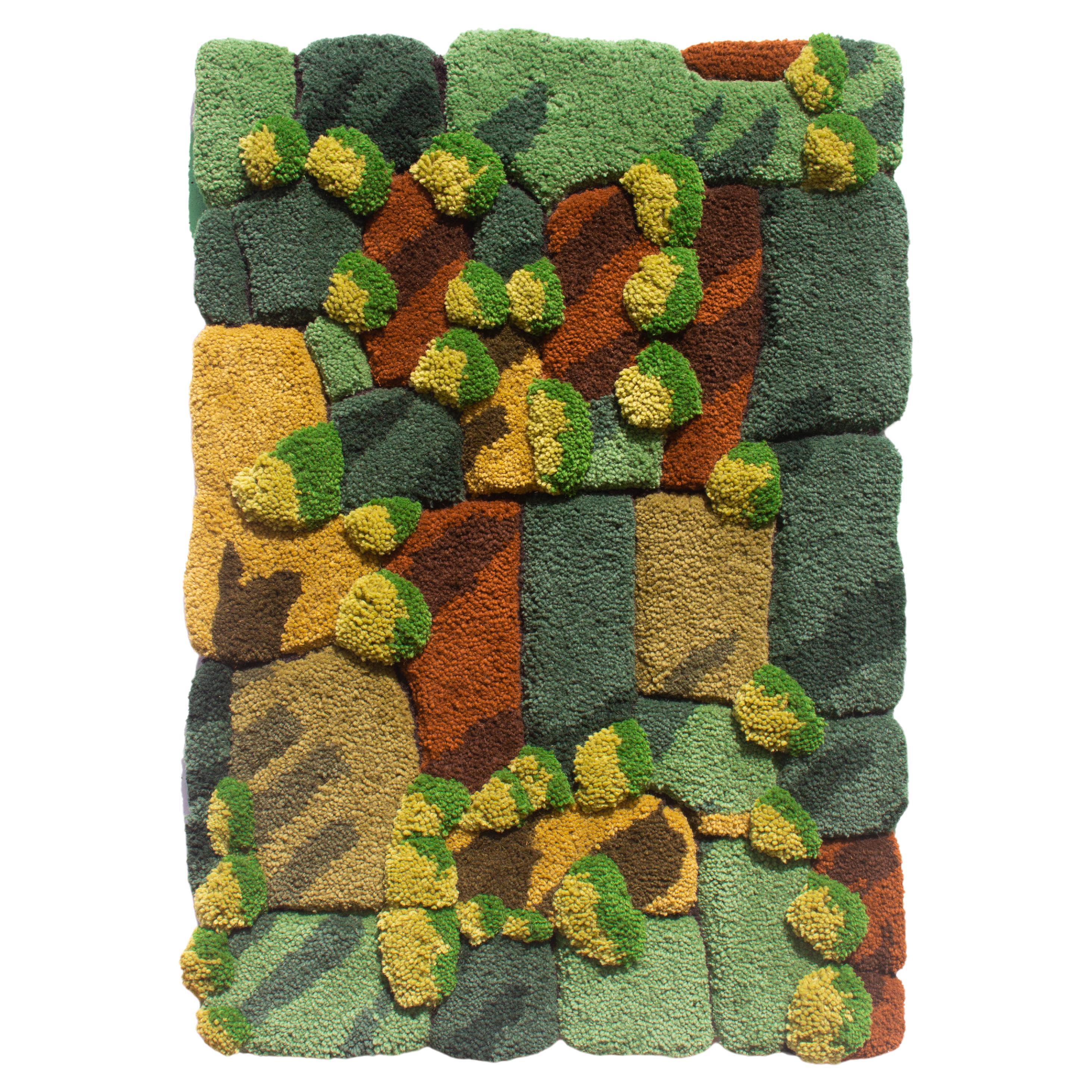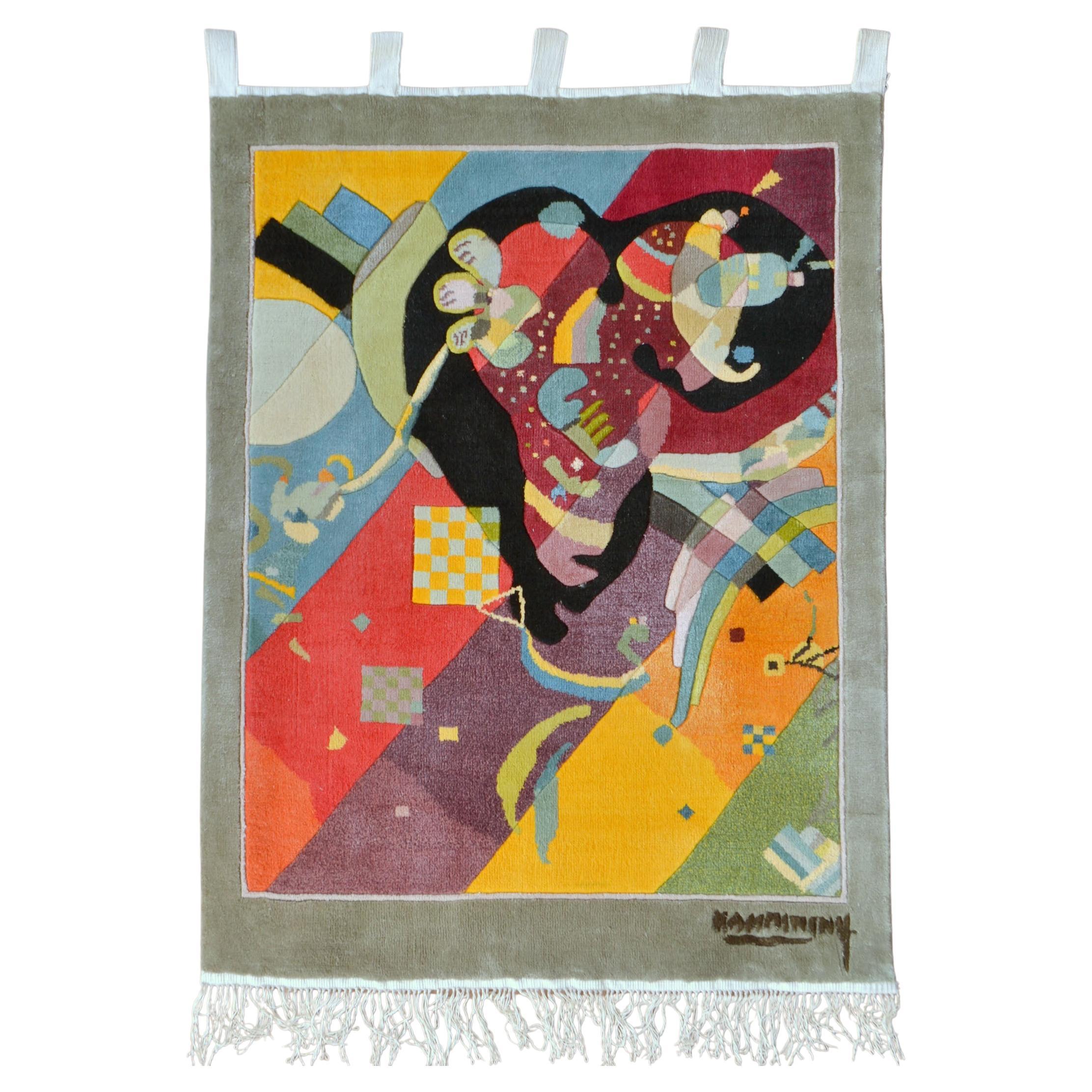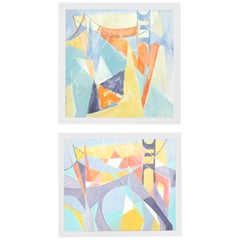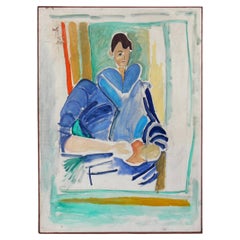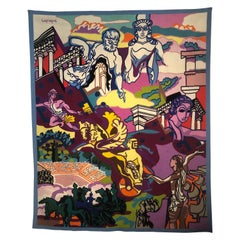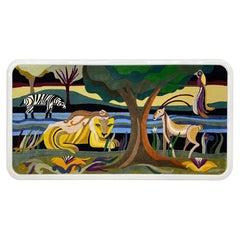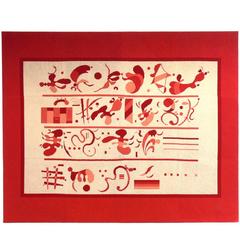
Large-Scale French Modernist Tapestry
View Similar Items
Want more images or videos?
Request additional images or videos from the seller
1 of 7
Large-Scale French Modernist Tapestry
About the Item
- Dimensions:Height: 72 in (182.88 cm)Width: 58 in (147.32 cm)Depth: 1 in (2.54 cm)
- Style:Mid-Century Modern (Of the Period)
- Materials and Techniques:
- Place of Origin:
- Period:
- Date of Manufacture:1950s
- Condition:Wear consistent with age and use. Very good original condition. Minor faint soiling commensurate with age and use. Minor surface wear, mainly to edges of frame.
- Seller Location:Atlanta, GA
- Reference Number:1stDibs: LU87185318673
About the Seller
4.6
Vetted Seller
These experienced sellers undergo a comprehensive evaluation by our team of in-house experts.
Established in 1996
1stDibs seller since 2009
2,198 sales on 1stDibs
Typical response time: 3 hours
More From This SellerView All
- Pair of Modernist Tapestries after Robert MotherwellBy Robert MotherwellLocated in Atlanta, GAPair of Modernist needlepoint tapestries after Robert Motherwell, circa 1970s. They have been framed in clean lined black lacquer wood frames.Category
Vintage 1970s American Mid-Century Modern Tapestries
MaterialsWool, Wood
- Large Scale Abstract PaintingsLocated in Atlanta, GASelection of large-scale abstract paintings, artist unknown, probably American, circa 1960s. They have been framed in clean lined white lacquered gallery frames under UV resistant gl...Category
Vintage 1960s American Mid-Century Modern Paintings
MaterialsGlass, Wood, Paint, Paper
$1,600 / item - Large Scale Modernist Portrait Painting in the Manner of Francis BaconBy Francis BaconLocated in Atlanta, GALarge-scale modernist portrait painting in the manner of Francis Bacon, probably American, circa 1960s. Artist unknown, not signed or mark...Category
Vintage 1960s American Mid-Century Modern Paintings
MaterialsCanvas, Wood, Paint
- Selection of Large-Scale Abstract PaintingsLocated in Atlanta, GASelection of large-scale abstract paintings, artist unknown, probably American, circa 1960s. They have been framed in clean lined white lacquered gallery frames under UV resistant gl...Category
Vintage 1960s American Mid-Century Modern Paintings
MaterialsGlass, Wood, Paint, Paper
$1,600 / item - Selection of Large-Scale Abstract PaintingsLocated in Atlanta, GASelection of large-scale abstract paintings, artist unknown, probably American, circa 1960s. They have been framed in clean lined white lacquered gallery frames under UV resistant gl...Category
Vintage 1960s American Mid-Century Modern Paintings
MaterialsWood, Paint, Paper, Glass
$1,600 / item - Large Scale Abstract PaintingLocated in Atlanta, GALarge-scale abstract painting, American, circa 1960s. It measures an impressive 50.25" height x 42" width. This piece is currently unframed. If you prefer a black gallery frame (as s...Category
Vintage 1960s American Mid-Century Modern Paintings
MaterialsPaint, Canvas
You May Also Like
- French Artist Charles Lapicque Tapestry Limited Edition 1/2 "Pelops", 1964By Charles LapicqueLocated in Paris, FranceExceptional limited edition 1/2 tapestry "Pelops" with certificate from a private collection, 1964. Ateliers Pinton brothers in Felletin, under the supervision of Pierre Baudouin 2ex + 1EA Editor Aram Iynedjian. The tapestry will be sold with its certificate of authenticity from the gallery. From the 15th century, the name of Pinton was associated with the Aubusson tapestry. Since then, over the generations, the Pinton family has largely contributed to the development of this fabulous cultural heritage until the creation in the 19th century, of the Felletin factory, in the department of Creuse. Even today, in these workshops, the craftsmen execute the same correct gestures with the same attention to detail and thus extend the chain of the history of the tapestry of tradition but also contemporary. The hand of specialists, the eye of designers and dyers and the taste of the most demanding clientele find their meaning in the fabric of the carpets. The excellence of French know-how, a living heritage society and custodian of Aubusson's cultural heritage, has always collaborated with great artists. The works of Charles Le Brun, Charles Lapicque, Pablo Picasso, Jean-Michel Othoniel, and many other big names in the world of painting, architecture, design, fell into the looms and know-how ancestral of this unique Creuse creator. Editor Aram Iynedjian Aram Iynedjian, Lausanne gallery owner and editor of tapestries from Braque, Estève and Lapicque, the latter meets Pierre Baudouin, the most famous of the cardboard painters of the time. The one who translated the works of Le Corbusier, Calder or Picasso into tapestry then collaborates with Charles Lapicque and they will develop a work of great richness. Lapicque came to realize these two summits which are "Pélops" and "Diane et Actéon". I realize that you should never try to describe a work of art Let’s look at it. Let us admire the science of composition, linear purity, technical perfection, the beauty of color, the truth of the drama. Let us see, if we can, the implacable presence of genius. "We will now understand that after having based a painting on the love of tapestry, it was relatively easy, and very tempting, to build a tapestry faithful to my painting," explained the artist in the exhibition catalog. of the Galerie Verrière in 1970. It was not until 1961 that he began to produce cardboards both for the tapestry of the Lisse in Aubusson, but also at the Mobilier National, with the help of Pierre Baudouin Charles Lapicque (1898-1988) Born in 1898 in Theizé (Rhône) in a family practicing both the arts and the sciences, Charles Lapicque is no exception to the rule: gifted for music and drawing, he graduated from the École Centrale in 1921, works as engineer until 1928 before integrating in 1931 a laboratory at the Faculty of Sciences of Paris, where he carried out research on the perception of colors, crowned by the title of Doctor of Physical Sciences in 1938. He thus studies the reactions of the eye in front of an intense light source, at the origin of the formation of starry images which he will use in his works, and defines a theory of the staggering of colors in space which overturns the rules of the Renaissance: "I had shown that the Classic rule, that of Vinci, advocating placing the blues in the distance, the reds, oranges and yellows in the foreground, is a nonsense; it makes more sense, more favorable to do the opposite. "(In Red and blue in the arts, 1936) It was around 1920 that Charles Lapicque began to paint in Brittany where he spent every summer since his childhood, first on the motif and then in a workshop that his stepfather Jean Perrin, Nobel Prize in Physics, had him build in 1927 ; he then definitively adopted the work of memory, in accordance with the art of music which he deeply loved and the Bergsonian philosophy of knowledge: "It is up to us to give reality an appearance that it has no itself, a form, a figure (...). " His youthful production immediately reveals a great originality, oscillating between figuration and abstraction which sometimes intertwine: alongside synthetic paintings by their simplified drawing and their flat colors, he designs an Homage to Palestrina (1925), composed of a grid derived from Cubism, entirely abstract, relayed by a Christ with Thorns (1939), according to a principle that he will develop after 1939, in line with his optical discoveries. In fact, during the war years, an almost abstract period began, that of the tight blue framework, applied to backgrounds ranging from yellow to red and revealing a more or less identifiable world (Jeanne d'Arc crossing the Loire, 1940; Rencontres series, 1940-1945). Exhibited in 1929 by the gallery owner Jeanne Bucher, Lapicque abandoned his scientific career in 1943 to devote himself entirely to painting. He continued his work which resulted in 1946-1953 in white-frame structures; their much softer lines lead him to the system of either black or white interlacing which encloses areas of pure color, most often in solid color. With The Battle of Waterloo in 1949, Lapicque still uses optics - zooming in on a given area - to depict spaces with multiple perspectives and decomposed times. This new interest in the liveliness of color developed in the following period, which can be described as flamboyant or Baroque (1954-1963): illustrated in particular by the series of Breton lagoons and twilight or nocturnal views of Venice in the light. Stars, which the artist himself describes as “daring sweets”, it begins with the Raoul Dufy Prize of the Venice Biennale, awarded in 1953 to the artist who took the opportunity to give free rein to his passion for the Serenissima until July 1956. Another point in common with his elder brother is the expression of movement. Begun in 1949 in The Battle of Waterloo then in 1952 with Dimanche aux regates, it became an obsession from 1964, in the exploration of new themes, such as the different shots of tennis players captured on the fly (1965), the mythological scenes and sea storms. These dizzying years precede the artist's last period: as he comes of age, he discovers serenity, revealed by a painting now with acrylic paint, much more peaceful from 1974, which even borders on a childish naivety at the end. of his life. All of his work includes an astonishing diversity of themes, also nourished by his travels (Rome in 1957, Greece in 1964, Holland in 1974 ...), with a predilection for the sea, rocks, sailboats, music, tennis, horses, wild beasts, but also for history and mythology, as evidenced by knights, kings and ancient gods. It also deploys, in total creative freedom, a wide variety of styles and orientations. Having been one of the pioneers of non-figurative art, thus paving the way for artists like Manessier, Bazaine, Vieira da Silva, De Staël, etc. Owners of the new non-figurative Paris School of the Postwar period, Charles Lapicque then returned to figuration, in a "new interpretation" of appearance, even if he continued to rub shoulders with abstraction at times. "Drawing runs after color and color after drawing. " Heir to the Fauves, Charles Lapicque plays like them on pure colors, whose dissonances, associated with a totally free design and an overloaded composition in a multiple space, make him a precursor of the New Figuration in all its forms: the Narrative Figuration born in France in the early 1960s, represented in particular by Gérard Fromanger, Erró, Bernard Rancillac and Gérard Guyomard; Free Figuration born in the early 1980s, marked by Robert Combas, Hervé and Richard Di Rosa, Louis Jammes and François Boisrond, and which, in turn, influenced the American Bad Painting of a Jean-Michel Basquiat or a Keith Haring, deliberately neglected and Expressionist; Lapicque's “Classic subjects” were able to feed Cultivated Painting, which also appeared in the early 1980s with Jean-Michel Alberola, Patrice Giorda and Gérard Garouste...Category
Mid-20th Century European Tapestries
MaterialsWool
- French Cubist Art Tapestry Title " Musique Tropicale" by St Epin Paris FranceLocated in North Hollywood, CAFrench Cubist Art Tapestry Needlepoint, Title " Musique Tropicale" Tropical Music by St Epin Paris Tapestries. Inspired by the work of kandinski, Picasso, Braque, Fernand Leger, and more French cubist and fauvisme artist. Handcrafted in a kaleidoscopic array of bright colors, tangerine, emerald green, yellow, purple, deep sky blue and black. This Cubist vintage needlework...Category
Mid-20th Century French Post-Modern Tapestries
MaterialsTextile
- Helen Webber Signed Monumental Large Custom Framed Jungle Scene Woven TapestryLocated in Studio City, CAA truly stunning, one-of-a-kind work by California master tapestry artist Helen Webber featuring various wild natural creatures in an African jungle scene. The colors are so rich and vibrant. This, without question, is one of the most wonderful pieces we have come across in some time. A vibrant, rich, heavy, substantial work overall. Displayed in a custom crackle finish frame. Sure to stand out in about any setting. This work leaps off the wall. Truly a designer's dream. The tapestry is signed by Webber in the lower left. Webber's works can be seen in a number of various settings including worship centers/churches/temples, hospitals and health care facilities (Betty Ford...Category
Vintage 1980s American Modern Tapestries
MaterialsFabric, Wool
- 5' Shearling/Leather Vertebrae Pill Tapestry X by Moses NadelBy Moses NadelLocated in Oyster Bay, NYThe Vertebrae Pill Tapestry X is the pill; shaped variation of our Vertebrae Tapestry X! It brings an organic vibe to the walls of any room. Designed with shearling panels (colors: ...Category
2010s American Organic Modern Contemporary Art
MaterialsLeather, Sheepskin, Wood
- Horizon Marine Tapestry by Jean Picart Le Doux, Signed, Great ConditionBy Jean Picart Le DouxLocated in Kansas City, MOLarge Jean Picart Le Doux "Horizon Marin" tapestry handwoven at Atelier Pinton in Aubusson France. Signed. Limited edition. Virtually no signs of wear. ...Category
Vintage 1960s French Mid-Century Modern Tapestries
MaterialsWool
- 'Fleeting Glimpse', Contemporary Abstract Tapestry by Jo BarkerLocated in London, GBThe vibrancy of fleeting glimpse demonstrates Jo Barker’s deep understanding of color, tones and textures to create beautiful handwoven tapestries. Here, her use of color is challeng...Category
21st Century and Contemporary British Contemporary Art
MaterialsTapestry
Recently Viewed
View AllMore Ways To Browse
Bass Relief
Antique Egyptian Tapestry
Egyptian Tapestry Antique
Owl Tapestry
18th Century Tapestry Cartoon
Unicorn Tapestry
Antique Japanese Silk Tapestry
Japanese Silk Tapestry Antique
Monogram Tapestry
Large Antique Flemish Tapestry
Silk Embroidery Picture
Silk Chinese Wall Hanging
Elephant Tapestry
French Jacquard Tapestry
Tapestry With Cherubs
Belgium Tapestry History
Lurcat Aubusson
Chinese Silk Embroidered Tapestry


